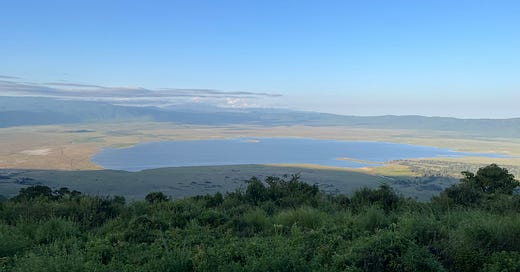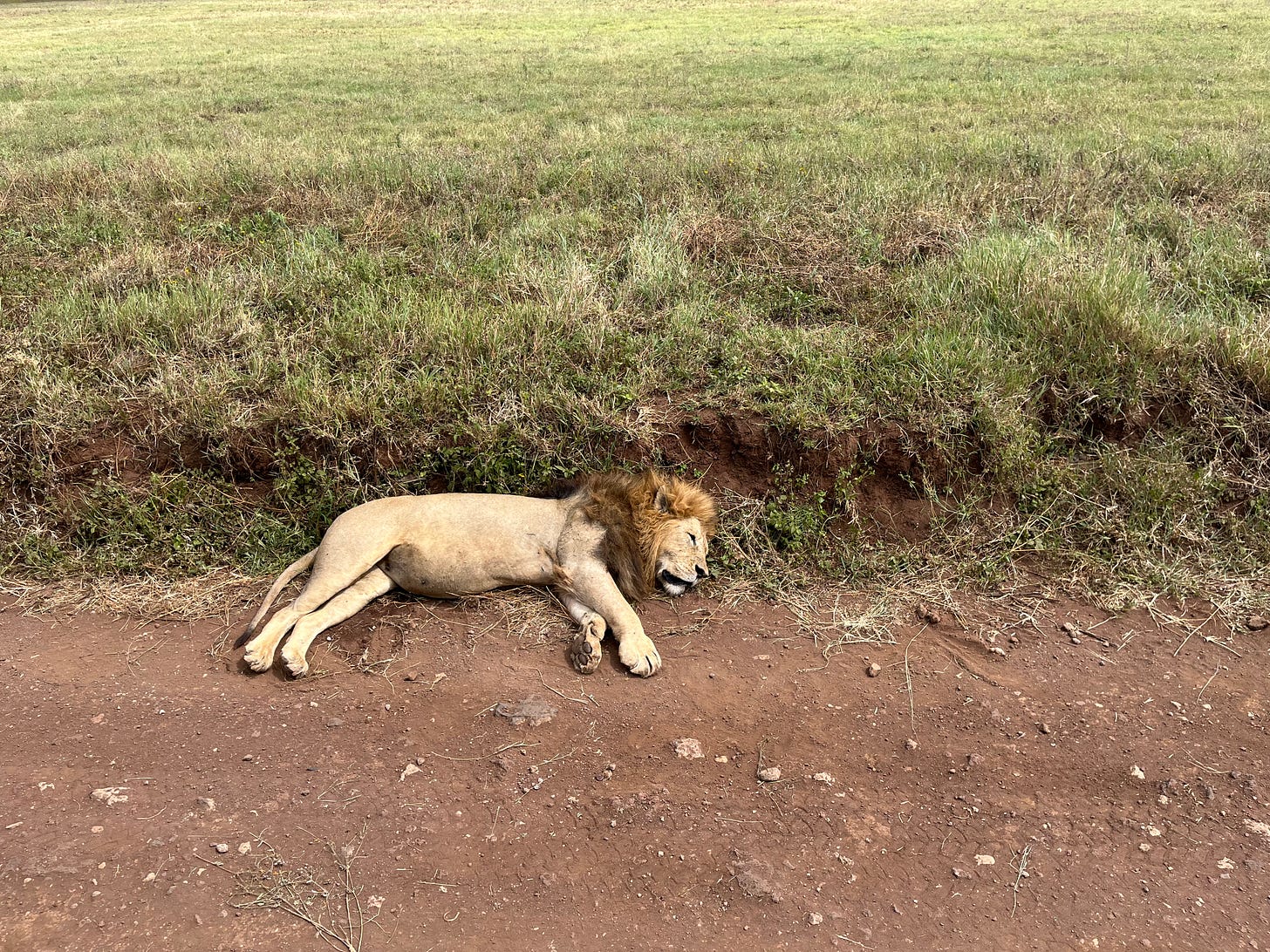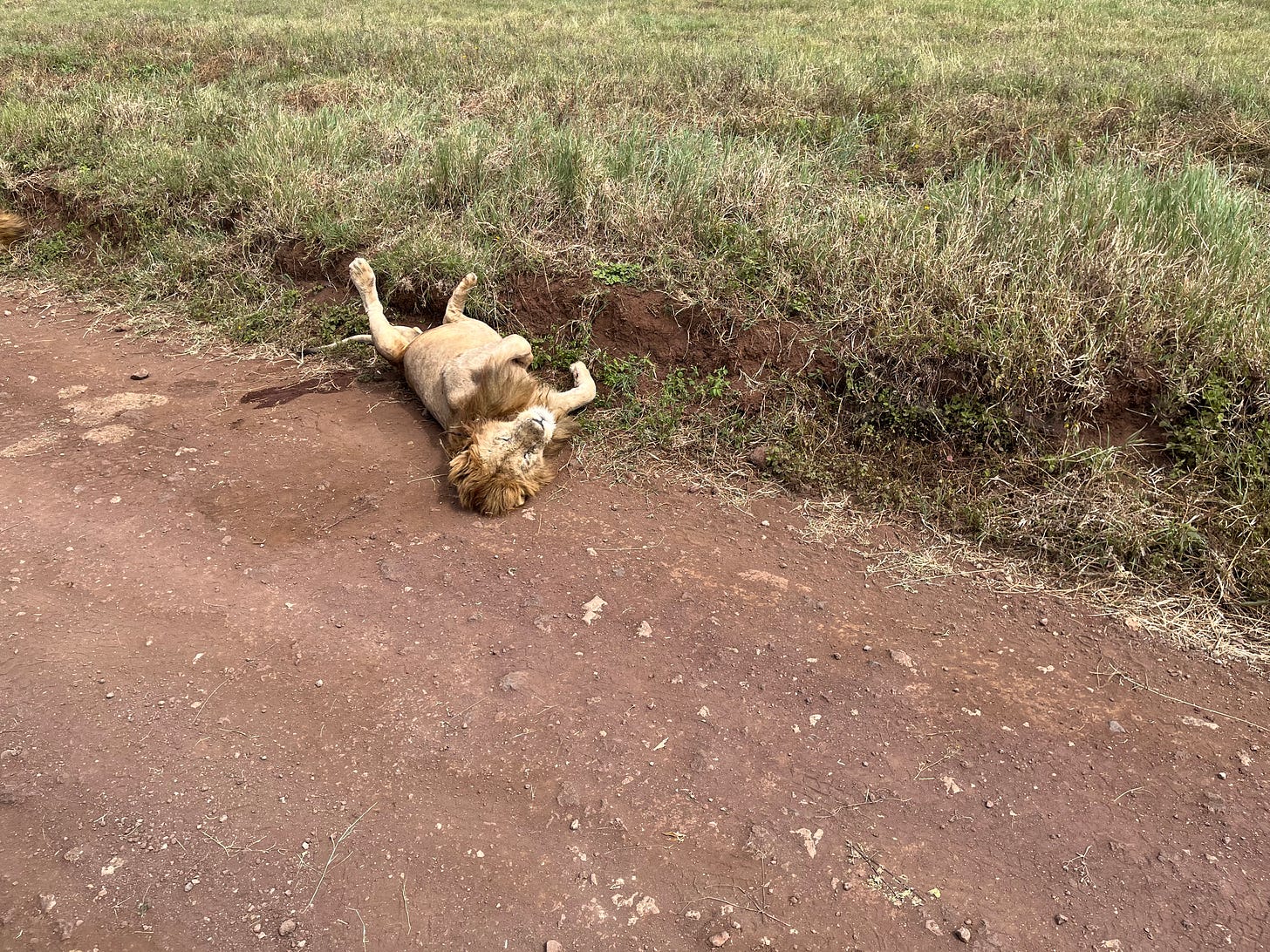Karatu, Tanzania
May 31, 2025
[NB: Our journey started last weekend. Previous installments are here, here, here, and here.]
We’re traveling astride the Great Rift Valley… an intercontinental system of ridges and ruts running from southern Turkey to Mozambique. Along it lie the Ribbon Lakes of this region, the Red Sea, Gulf of Aqaba, Dead Sea, and Lake Gennesaret.
Beneath us, fidgety faults are splicing Africa into separate plates: the Nubian carrying most of the continent west, the Somali sending the horn of Africa toward Asia.
The rift formed in the Miocene, about 25 million years ago. Active volcanoes and brittle faulting dot and define this dynamic topography.
For the moment, we’re just south of the equator and more than a mile above sea level. But as mantle plume keeps heating and heaving the overlying crust, the terrain will continue to expand and fracture… and move us east.
As it does, the valley slowly sinks, till one day ocean water will flood the basin. With any luck, that won’t happen in the next few weeks.
While we wait, the rift lakes remain permanent basins for local rivers. As incoming streams deposit sediment, they store fossils that capture an anthropologic record… which extends back millions of years.
Tectonic shifts open dusty panes to humanity’s past. As lakes migrate with moving plates, their inputs carve layers revealing a thousand centuries of encased fossils. It’s like natures versions of a roadway cut.
Some of the larger ones are in the Ngorongoro Crater, the largest intact un-flooded caldera in the world. A couple hours west of Arusha, this remnant of an extinct volcano is a maternity ward of prehistoric man. Our lodge is perched along the crest of the crater.
As when Edmund Hillary climbed Everest or Roger Bannister broke the four-minute mile, the discoveries of Louis and Mary Leakey opened the floodgates to eclipse accomplishments previously thought impossible.
Of all places on the planet, few feature evidence of earlier human habitation. Since the Leakeys’ discoveries in the Olduvai Gorge, fossilized remains of hominids and encrusted remnants of cultural behavior have increased exponentially.
The gorge is divided into five geological layers, with a main branch and side off-shoots, with distinct species of hominids known as Australopithecus and Homo Habilis found within the lower pleats of volcanic ash.
Among the fossils were roughly chipped rocks believed to be the earliest known stone tools. Within the layers of sediment and stone were the bones of those who crafted these implements. These mark the onset of the Paleolithic Age.
The Ngorongoro remains home to some humans. Masai inhabitants had dwindled to fewer than a thousand after the Second World War. But they’ve increased a hundred-fold the last eighty years.
From the perspective of a government maintaining a wildlife reserve, their proliferation is a “problem” primarily because of their cattle, which competes for food with zebra, wildebeest, and a menagerie of protected critters within the crater.
Toward the top of the volcano, thatched roofs cover Masai huts, the number of which do not directly reveal prosperity of Masai man. His wealth is more accurately measured in cattle, wives, and children… often in that order.
Heavenly Illumination
Our visit came by way of Lake Manyara, a soda lake at the foot of the Great Rift Valley. Like many protected areas of east Africa, what’s now the Manyara Reserve was once used for hunting.
Unlike other game preserves in the region, Manyara is thick with foliage. Its designation as home of “the climbing lions” is a marketing gimmick. Not because lions are rare, but because trees are ubiquitous.
All lions can climb. But most parks have few trunks to claw or limbs to lounge on, so Manyara makes the most of what makes it unique.
While we were there, whatever lions it boasts were hidden by leaves. We consoled ourselves with an assortment of baboons, monkeys, elephants, and antelope.
From Manyara our voyage carried us up the wall of Ngorongoro, and to our rooms atop the caldera.
This morning we awoke to a startling sunrise over Lake Magadi. Like a night watchmen protecting the darkness, clouds deflected incipient rays into the water below.
It was as if the light were on at the base of a pool. Heavenly illumination seemed to ascend, dissolving fog to dissipate the dawn. The caldera lake, floor, and walls slowly came to view.
Before us was the reputed cradle of man. With that qualification and its abundance of wildlife, this geologic goblet can make its case as the Garden of Eden.
We drove down from 7,600 feet. Thru the mist, a group of giraffes roamed the top of the ridge. Their long front legs prohibit them from journeying into the caldera, so they wished us well on the steep decline.
The bottom of the bowl is more than a mile above the sea. A distant elephant lumbered alone on the dry prairie west of the lake, a saline basin within the grip of a graben.
Her Own Script
Gazelles were first to greet us: First a handful, eventually hundreds. A lone rhino posed in the distance, herds of buffalo shuffled near the water, and confusions of wildebeest bumbled across the road.
To our astonishment, we found two male lions lyin’ on one side of it. Both were asleep, as lions typically are twenty hours each day.
Aside from one of them casually rolling onto his side, they didn’t flinch at our being a few yards away.
Several minutes later, three females were resting within a couple hundred feet. In the distance, dozens of wildebeest began to gallop. For whatever reason, one decided to break away.
He trotted toward our truck. Between him and us, one lioness tucked her ears and lowered her back. As her hind legs prepared to pounce, the oblivious wildebeest continued to approach.
Our only option was to start recording. A few seconds after I did, the prospective prey perceived his plight.
Seeing his predator, he changed course, picked up speed… and ran away. The lioness relaxed, and resumed her watch.
Lions are more liable to pounce than to chase. Rather than speed, they rely on strength and surprise. Their strategy is to stalk and ambush.
Occasionally they get lucky, and fresh meat falls in their lap. Sometimes our luck fails, as when we narrowly miss a wildebeest serving himself up.
We were disappointed to not see a kill. But as our guide reminded us, “Mother Nature always writes her own script, but it’s always blessing us.”
He was right.
A few minutes earlier, we’d seen a rarity. A few channels connect a small pond to the main lake. Within it was a large rock… that began to move.
Like a giant slug slithering to shore, the mighty hippo pierced the surface. A couple others soon appeared, and make their way into one of the canals. Like the Ever Given blocking the Suez, the twin beasts clogged passage.
Behind the initial hippo, a small object floated on the pond. It was the “tiny” off-spring of the lead animal. With its mother, the baby came ashore.
Briefly.
Because of lions and other predators, it’s rare for infant hippos to leave the water. Within minutes, this one jumped back in… before emerging again and hiding in the grass.
Loyal Sentries
Most of the morning we were among Zebras. Like sheep dotting the fields of Ireland, they filled the flatlands on the far side of lake. Many surrounded us for our al fresco lunch.
On the water, flamingos flourished. But rising salinity places their sanctuary at risk. Beyond the birds as we rode away, the tusks of a half dozen elephants glistened in the sun.
As we made the ascent up the caldera wall, a troop of baboons flanked the road. Further up, we approached the lodge.
As we made the turn, our loyal sentries remained at their post. Standing watch above the world, a troop of giraffe welcomed us home.
JD











Wonderful and educational log of your travels in a part of the world few visit; great photos, especially the one of Lake Magadi at daybreak. Several informative expressions struck me as artful. e. g., "... dissolving fog to dissipate the dawn'"